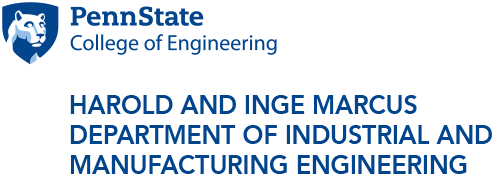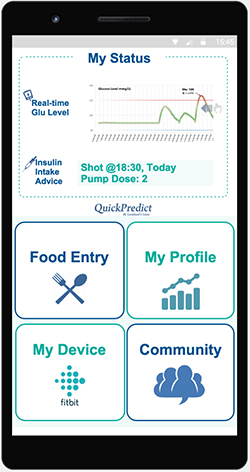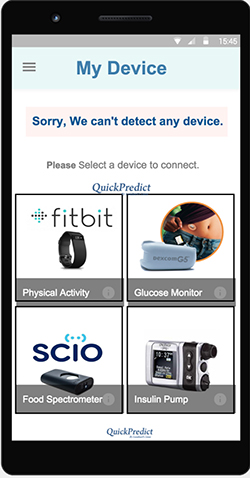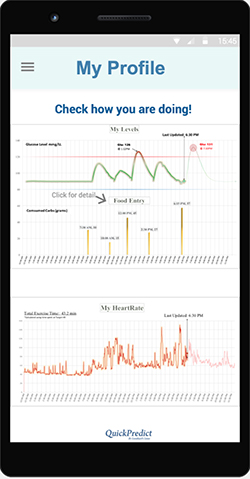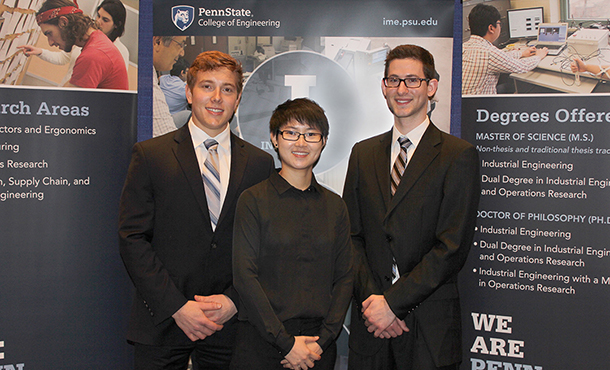
Industrial engineering students Kyler Houser, Jess Li and Joshua Binder presented their QuickPredict mobile app at the 2016 Institute of Industrial and Systems Engineers Annual Conference & Expo in Anaheim, California.
Students engineer app to help Type 1 diabetics, win national award
5/27/2016
UNIVERSITY PARK, Pa. — A group of three Penn State industrial engineering students took home first place honors in a national competition for developing a mobile application that could potentially save lives.
Jingwen (Jess) Li, a third-year doctoral student, along with recent graduate Josh Binder and senior Kyler Houser, under the direction of Professor Vittal Prabhu, set out to develop a mobile application in the home health care domain that will allow patients to better manage their conditions on their own without as much intervention from their doctors.
The group worked to incorporate already-existing technology into an easy-to-use mobile app that is designed to help people with Type 1 diabetes better monitor and manage their condition independently.
The app — called QuickPredict — placed first, beating out finalists from Binghamton University and the University of Washington, in the 2016 Institute of Industrial and Systems Engineers (IISE) Computer Information Systems Division Mobile App Competition at the institute’s annual conference in Anaheim, California.
The Penn State team was awarded $600, donated by IBM, for its winning design.
“We decided to focus on Type 1 diabetes because it is a condition that needs to be constantly monitored and managed,” said Houser. “When we thought about the importance of regularly checking blood sugar levels and making sure people get adequate exercise, it seemed natural to create an app since mobile devices are so prevalent in society and are becoming increasingly relied on to manage daily tasks.”
According to the American Diabetes Association, the body does not produce insulin in people with Type 1 diabetes. The body breaks down the sugars and starches eaten into glucose, which it uses for energy. Insulin is a hormone that the body needs to get glucose from the bloodstream into the cells of the body so people with Type 1 diabetes need to give themselves injections of insulin to make up for the body’s inability to produce the hormone. Exercise is also an important part of keeping diabetes under control.
QuickPredict incorporates parameters like efficient food input, real-time physical activity monitoring, continuous glucose monitoring and published glucose predictive models in order to optimize wellbeing and reduce the human error component in effectively treating Type 1 diabetes.
According to the team, there are some existing applications, such as Logbook, that are specifically developed to encourage diabetics to record their activities as well as their blood glucose levels. In return, the technology offers feedback on the user’s health status by supplying a model of blood sugar readings over time, accompanied with visual references and interactive inputs. This type of app allows people to estimate the proper insulin dosage at the appropriate time.
Currently the most direct approach to determining the correct insulin amount is by using a continuous blood glucose monitor, which provides real-time glucose levels as a guideline for insulin dose and time. However, there is always a time delay between the sensor data and the true blood glucose level, which has led Li, Binder and Houser to research models that can predict blood glucose level ahead of time given patient’s blood glucose level as well as his or her food intake.
From a patient’s perspective, manually inputting physical activity and food nutrition information is tedious and time-consuming.
“We wanted to focus on how we could take advantage of technologies already out there and incorporate those into the app so people don’t have to guess as to how much exercise or physical activity they are getting throughout the day,” said Li. “That data is automatically drawn in and people will get a reading on how much insulin is needed and when.”
QuickPredict pulls in data from various data sets including activity-monitoring devices (or “smart watches”), food nutrient counters, wearable blood sugar monitors and GPS location services so it can predict the blood glucose ahead of time and suggest a recommended insulin dosage at any specific time of day.
“We believe a patient would prefer a clear and concise suggested insulin dosage at any given time, rather than being left to interpret a complex mathematical model and graph,” said Binder. “QuickPredict recognizes the opportunity to improve current applications, and aims to leverage existing modern technologies and integrate them in creating a user-friendly app that will take the guesswork out and improve the quality of life in people with Type 1 diabetes.”
As work on the app continues, the team would like to come up with a business plan and bring in a technology partner to work on adding additional data sets from which the app can pull that would make it even more user friendly, such as menus from popular restaurants.
Li, Binder and Houser traveled to the IISE conference to demo their app on May 22, thanks to funds provided by the Harold and Inge Marcus Department of Industrial and Manufacturing Engineering’s Service Enterprise Engineering 360 initiative.

